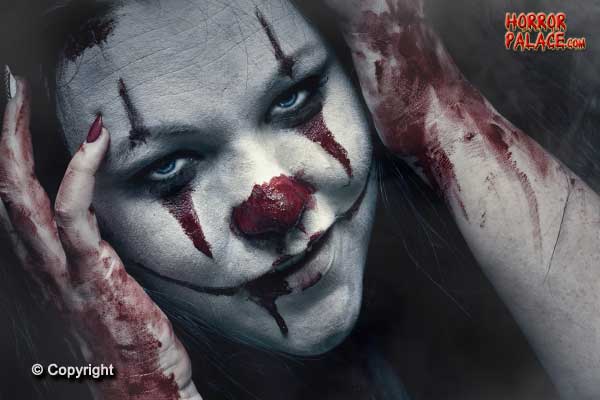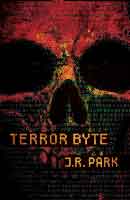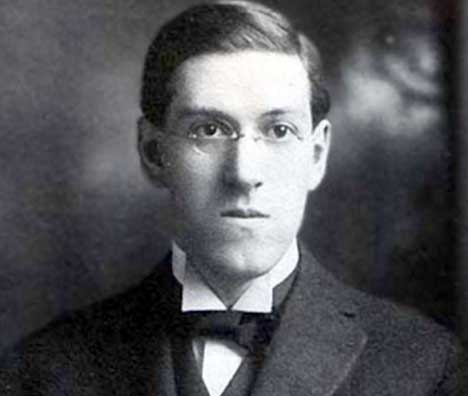 Nobody knows how her spell of insanity came about, but the voices in her head urged her to mask herself behind the makeup of a special clown. This gives her the power to commit the hideous deeds that are typically associated with world class cannibals. What starts out as an innocent joke ends with a wine glass filled to the brim with blood. Her psychopath approach to ripping out organs with her bare hands has yet to be equaled. When she makes you laugh, make sure to enjoy it completely, because you will never laugh again.
Nobody knows how her spell of insanity came about, but the voices in her head urged her to mask herself behind the makeup of a special clown. This gives her the power to commit the hideous deeds that are typically associated with world class cannibals. What starts out as an innocent joke ends with a wine glass filled to the brim with blood. Her psychopath approach to ripping out organs with her bare hands has yet to be equaled. When she makes you laugh, make sure to enjoy it completely, because you will never laugh again.
Terror Byte (Book Review)
 A mysterious flashdrive ends up in the hands of an unsuspecting victim. Unaware of its power, the victim explores the content of the flashdrive. Within a matter of minutes 30 people die a violent and horrendous death with no explanation or witnesses to the source of the mass murder. The case proves to be one that police logic won’t be able to figure out without some extraordinary theories, in addition to taking some extraordinary risks.
A mysterious flashdrive ends up in the hands of an unsuspecting victim. Unaware of its power, the victim explores the content of the flashdrive. Within a matter of minutes 30 people die a violent and horrendous death with no explanation or witnesses to the source of the mass murder. The case proves to be one that police logic won’t be able to figure out without some extraordinary theories, in addition to taking some extraordinary risks.
Detective Norton is the experienced individual who is responsible for figuring out the mystery. Unfortunately, he still has some demons to deal with and this only complicates matters for him. As he tries to pull himself together and find whatever is behind all the dead bodies, things take a dramatic turn for the worst. He comes into contact with a mysterious woman who gives him even more trouble, but she also might have the answers he is looking for. As they meet for a second time the case becomes more complicated and difficult to solve.
With a highly unlikely partner, Norton faces a wall of resistance towards clarity. All his experience and skill come into play as he partakes in high speed chases and life threatening confrontations. The odds are squarely stacked against him and nobody can be trusted. Will Norton survive long enough to find the truth?
The author, J.R. Park, has a great way of coloring the scene. He provides a lot of attention to details, both physically and mentally. Park also makes it easy to paint the scenario within the imagination and for a short story this can be difficult to do. The characters are well thought out as the story touches on the important aspects that give them life so-to-speak. Even though some of them play a tiny role they are quickly summed up within a single page.

The real magic of the story lies in the the action scenes along with the graphic explanations that accompany the death of the characters. Park leaves no stone unturned in describing the feeling of the horror as well as the tiny details of how injuries are inflicted. In this manner Park brings another dimension to horror and death.
Shrouded in mystery, the story takes unexpected turns. There is no telling who is going to die next or where the horror behind the mysterious murders is going to end. It’s suspenseful and sometimes even sincere, especially the leading character Norton. His internal turmoil over a situation he wanted to prevent keeps on surfacing throughout the case. Silently he wishes for death while his principles to see justice served keeps him from committing suicide. The lack of closure and the constant memory flashes only makes his mission more difficult. In some cases it places him in more danger.
Overall “Terror Byte” was written with a great pace and a nice build-up towards a surprising climax. The plot is original in terms of the threat, although some of the characteristics Norton shows have been used before. It’s definitely a book that can go into the “memorable” category.
Damnetha is a staff writer, horror book and movie critic.
Other books by J.R. Park:
Upon Waking
Punch
The Raven
It’s only fair that the raven has a special place in horror. For centuries it has been a dark, yet spiritual symbol for so many cultures and it has inspired some of the best dark poetry the world has seen. Their mythical status is most likely rooted in their roles as mediators between life and death. As scavengers and carrion birds their reputation for connecting with the dead has grown extensively, giving them a dark sense of power and control. In some cultures they are considered good luck, but for the most part a raven represents death. Looking back on the history of ravens it’s obvious how they became such a big part of horror.
Cultural Depictions
In Greek mythology the raven was regarded as good luck, but also as a messenger for the god Apollo. However, the color of ravens at that time was white. Apollo had sent a raven to spy on his lover Coronis. When the raven returned to present Apollo with the news that Coronis wasn’t being faithful he scorched the raven out of rage. From there every raven was black.
For the Jewish community the raven is better known as one of the three animals on Noah’s Arc that was punished for copulating while the flood was still brewing outside. Across the colorful spectrum of cultures all around the world the raven has some mystical place. There are cultures that believe the raven is the creator of the world, but in the same breath it is considered a very sneaky god. Kings used them in battle and some just regard them as dark messengers. In Yakut mythology a raven is considered as the spirit of violence and war.
Despite the neutral and, on occasion, good legend of the raven, people have come to regard it as an animal that belongs to the darkness. The general consensus of ravens is that they are in fact bad omens and if you come in contact with them then something dreadful is bound to come your way. In some cases it can mean death or it can be torture of some kind.
Ravens in Literature
One of the most well-known writers, namely William Shakespeare, made good use of the symbolic raven. More specifically, he used them in his great tragedies such as “Macbeth” and “Othello”. Even Charles Dickens implemented the raven as a crucial character, by the name of Grip, in his book “Barnaby Rudge”. However, the most popular use of a raven in literary works is by far that of Edgar Allan Poe. In his poem, which is simply entitled “The Raven”, Poe paints the raven in a very obscure, scary and dark light. As the main character of the poem starts to fade into certain madness a raven comes to visit him. This visitation inspires the doomed character to talk to the raven, and when the raven only replies with a singular line the character just becomes more frustrated. Ultimately the supernatural messenger intensifies the man’s descend into madness. Several filmmakers have made movies based on this famously dark poem.
Numerous other writers like Christopher Marlowe and Edward spencer also incorporated the raven into their works as representatives of darkness. Even modern writers still find a large amount of inspiration from ravens, as can be seen on Horror Palace. One poet in particular captures the image of ravens quite well when he writes “Their capes of black plumage will cloak me in death.” (Ivan Karhoff). In fact, the intro to the dark poems on Horror Palace incorporate the ravens as a symbol of warning that what the reader is about to experience should not be taken lightly.
Ravens in Cinema
A film by Alfred Hitchcock called “The Birds” had a great effect on culture when it was released. Out of all the birds that attacked the town, crows and ravens were remembered the most and this just reinforced their dark image. This can be seen in the movies that followed “The Birds” such as “Kaw”. Instead of all the birds in the surrounding area becoming malicious and crazy, a swarm of ravens attack the town.
The Psychological Aspect
Compared to other animals that are used in horror, the raven is rather unique. The one thing Hitchcock and Poe understood quite well was the psychological aspect and power of the raven. It’s not a muscular animal that goes on killing sprees. Instead, it’s an animal that tortures until breaking point is reached. Its association with death and the mythology from which it comes provide an unnerving image which writers and directors can easily utilize. In most cases the victims within the poem, story or film isn’t necessarily afraid of the raven, but what it brings with it. They all know that it’s bringing some kind of message or warning, but they never know what it is. This brings more intensity and atmosphere to the scenario. You might also notice that nobody really tries to kill the raven. For some reason or another there is no attempt or forethought to destroy the messenger. The raven doesn’t need anything to enhance its presence and this alone is reason enough why ravens have, and always will be a perfect fit in the world of horror.
H.P. Lovecraft
 H.P. Lovecraft never got to see the success of his work. The small following he managed to create wasn’t significant enough to push his reputation into publishing success, leaving him poor and relatively unknown until the day he died. He had characteristics that could easily be compared to those of neurotic artists and painters, especially the isolation he typically found himself in. Sadly, his gift for writing strange and original horror stories was only discovered after he passed away. Now he is considered one of the most influential writers to ever grace the literary world. This is H.P. Lovecraft.
H.P. Lovecraft never got to see the success of his work. The small following he managed to create wasn’t significant enough to push his reputation into publishing success, leaving him poor and relatively unknown until the day he died. He had characteristics that could easily be compared to those of neurotic artists and painters, especially the isolation he typically found himself in. Sadly, his gift for writing strange and original horror stories was only discovered after he passed away. Now he is considered one of the most influential writers to ever grace the literary world. This is H.P. Lovecraft.
Childhood
Lovecraft was born in Providence, Rhode Island, on 20 August 1890. He never had the privilege of getting to know his father, because at the age of 3 he had to make peace with his father spending the rest of his natural life in a mental institution called Butler Hospital. Winfield Scott, his father, made a living as a travelling salesman and the products he specialized in were precious metals and jewelry. For reasons still unknown Winfield became acutely psychotic and 5 years after he was admitted to Butler Hospital he died. Lovecraft’s mother was noted as overbearing and the frequent sick spells he had when he was younger only made her worse. Along with his mother, Lovecraft was raised by his two aunts and grandfather. The latter was also the person who inspired his love for writing and reading. Through his grandfather he was introduced to classics like Bulfinch’s Age of Fable and The Arabian Nights. Later on he got to hear some original gothic stories as told by his successful grandfather.
Lovecraft only attended school until he was 8 due to his mother and his fragile health condition. During the time he spent at home he drenched himself in reading, chemistry and astronomy. He was considered a prodigy, seeing as he was reciting poetry since he was 3 and by the time he reached his 6th birthday he was writing them as well. When he returned to school he was already in his teens and he managed to expand his social skills. He made some friends and he handled the situation much better. It is speculated that he suffered from night terrors, which he called “night gaunts” and many believe they were a source of inspiration for his later work. His grandfather passed away in 1904 and this was something Lovecraft struggled to make peace with. To make matters worse, the mismanagement of his grandfather’s estate meant that Lovecraft and the rest of his family found themselves in poor circumstances. Before he could graduate he left high school, the reason being he had a breakdown. Without ever graduating, Lovecraft would spend the next 5 years pretty much isolated. Except for his mother who still lived in the same house, he didn’t see much of the outside world.
Adulthood
In these 5 years Lovecraft didn’t make any attempts to find work or to build friendships. Instead he wrote a letter to The Argosy, a pulp magazine in 1913. In this letter he questioned the quality of the love stories that were written by Fred Jackson. It sparked a heavy debate in the magazine’s letters column and also caught the attention of the president of the United Amateur Press Association (UAPA), Edward F. Daas. In 1914 Lovecraft was invited to join the organization. His first story was published in the “United Amateur” during 1916 entitled “The Alchemist”, but it was only in 1922 that the story was published commercially. He was 31 at the time and his network of correspondents grew dramatically. People like Robert Bloch and Clark Ashton Smith formed part of his network.
Rarely a person to come out during the day time, Lovecraft’s skin was pale and his dark eyes were deeply set. If he did go out then it was during the night. His mother was admitted to the same hospital as his father in 1919 after years of suffering from depression and hysteria. However, their relationship remained close and they too corresponded with letters. On 24 May 1921 she died due to complications from gall bladder surgery. A few days after his mother passed away he met his wife to be, Sonia Greene. She owned a successful hat shop and her membership to the “Blue Pencil Shop” helped them to cross paths. It was at an amateur journalist convention in Boston where they met and she was 7 years older. The gap in age didn’t seem to bother them. Her love for Lovecraft and his work ran deep. In fact, it ran so deep that she offered to support him financial. He moved to New York and started a new chapter in his life.
According to Greene, Lovecraft never really took initiative romantically. Through all the years he remained passive, even though he was blown away with his new surroundings. It was here that Lovecraft made more influential friends who spurred him on to submit stories to a magazine called “Weird Tales”. Many of his pieces were published, but not all the readers took delight in them. At some point he was asked to take an editorial position at the failing magazine, but he declined, because he didn’t want to move to Chicago.
Unfortunately his marriage with Greene had some rough spots, seeing as she lost her business not long after getting married. Lovecraft tried hard to support his wife, but his lack of work experience didn’t help. In the end Greene had to move around in order to keep working while Lovecraft stayed in a small apartment. The area, Red Hook, was rundown and he was also burgled, which left him with nothing but the clothes on his back. Ultimately he would move back to Providence in 1933 where he did his most prolific writing.
His last years were painful, because he was diagnosed with cancer and this led to malnutrition. Living under such poor conditions didn’t help and he died on 15 March 1937, one year after being diagnosed. It can be argued that Lovecraft could have been very successful while he was still alive. Unfortunately he didn’t take criticism well and when a book was rejected once he never tried to get it published again. His passive nature and sensitivity kept him from marketing himself effectively. Even when publishers reached out to him he didn’t respond.
His stories typically entail dream states, suicide, haunted areas and hidden cities. He also loved to tie in mental instability and ways of entering other realities. Lovecraft’s talent truly resided in stories that made sense without making sense. Just looking at some of his popular works like “The Rats in the Wall” and “Dagon”, it shows how he loves “the underground” or “hidden” city idea. Many other popular stories entail the dream state such as “The Tomb” and “Polaris”. In some cases he opted for cannibalism and grave robbing. He simply didn’t have a lack of imagination.
Horror Palace Poem
To a place called Horror Palace,
On your guard you must go.
For there’s more than just malice,
You’ll come to know
It’s fright and fun horrors,
You’ll have to bear
Behind which doors,
You’ll be unaware
The music, the stories,
and art is so grand.
Basking in glories
The spirit takes your hand,
It’s for your enjoyment,
Like the rabbit and Alice,
It’s beyond belief,
In a place called Horror Palace
“You have everything to fear!”
© Copyright 2014 HorrorPalace.com – Horror Palace,LLC All Rights Reserved.
